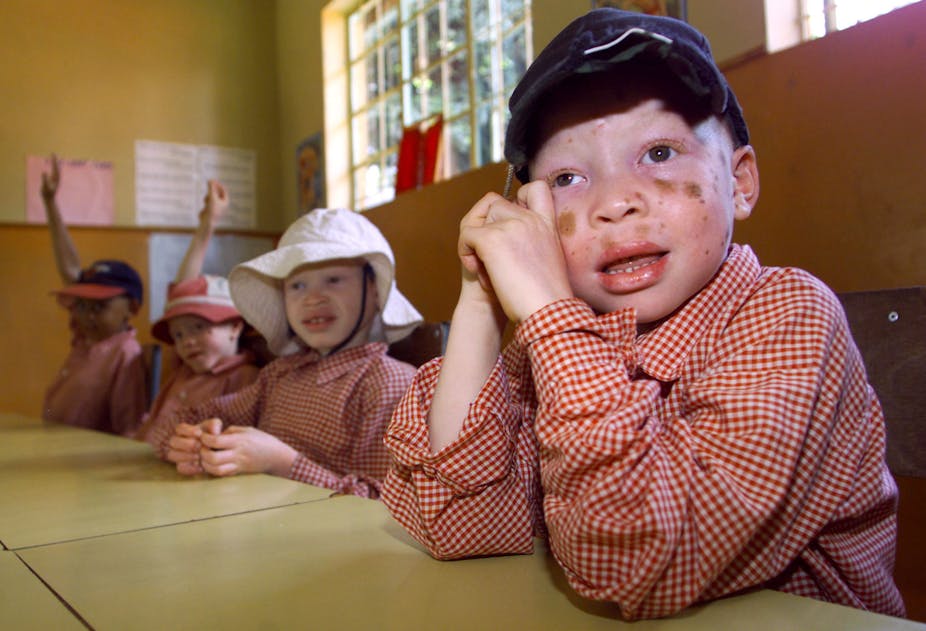In Tanzania, most students with albinism attend school alongside peers who don’t live with this condition. The idea behind this approach is that such inclusion will ultimately eliminate discrimination against those with albinism – important in a country where as many as one in 1,400 people are affected. Albinism, which is a defect of melanin production, comes with a number of associated health problems: poor vision, functional blindness, light sensitivity and skin that is very sensitive to heat and the sun.
But mainstream schools don’t have the sort of support services that children with albinism need, such as clinical eye and skin treatment. This is despite the country’s Persons with Disabilities Act of 2010 stating that:
[Children with disabilities] shall be provided with appropriate disability related support services or other necessary learning service, from a qualified teacher or a teacher assigned for that purpose.
Ideally, schools should have special-needs teachers who are trained in inclusive education and can assist students who need special attention. Such teachers should be employed from preschool level all the way through the system. This is not currently the case in most of Tanzania’s thousands of public schools.
There may not be trained special-needs teachers in every classroom, but there is plenty that ordinary teachers can do to support students with albinism. Some of this is very simple. Schools can also do more to bring in external specialists like ophthalmologists and optometrists to support these children.
Collaboration matters
Teachers need to know which of their students struggle with low vision, and set up seating plans accordingly. It’s not helpful to assume that all children can see the board or the teacher equally well from anywhere in the classroom. Teachers should work closely with children’s eye specialists to get this seating plan right. Such collaboration helps everyone in the long term. It means that students’ eyesight won’t deteriorate even faster; optometrists can ensure their patients are getting the best care even outside their treatment rooms and teachers can be sure their pupils are getting the best shot at learning.
Some students will not want to sit up front and should not forced to do so, but they should be provided with alternatives. People with albinism have sensitive eyes, so pupils with this condition should not be seated looking into direct sunlight nor beneath harsh overhead lights. Teachers should also remember that students with albinism might struggle to read from overhead projector screens because of the glare. These students should be allowed to copy the acetate sheets once the teacher is done with each.
Font sizes can be also an issue for children who are visually impaired. Teachers must take the time to sit with their students and check whether particular handouts and texts need to be enlarged. This process is very empowering for students, too. It makes sense, after all, that teachers should consult directly with the people who are most affected: pupils themselves.
Finally, students with albinism need to be given extra time to finish writing exam scripts and schools must ensure that these are presented in large, clear fonts.
Encouragement is key
Students with albinism may have to use standing or handheld magnifiers or special reading glasses, such as bifocals with a strong telescopic lens clipped over them. They are often reluctant to use their optical aids, which draw attention to them – they are, after all, children or teenagers! Some pretend that they can see fine without these optical aids. Younger pupils may hide, lose or break their glasses deliberately.
Teachers can help with this discomfort by dealing with other pupils who bully their visually impaired peers. They can also talk enthusiastically about the optical aids and their benefits.
This sort of encouragement must go beyond the classroom setting. Children with albinism may avoid playground activities or sports, since their skin is extremely sensitive to the sun. They may also be left out by the other children. Teachers can suggest that children with albinism try sports that don’t expose them to the sun – like aerobics and gymnastics. They can also teach other pupils about tolerance and inclusion.
There is another side to all of this teacher support, though: if teachers get too involved, they may be accused of favouritism and draw more unwanted attention to their students with albinism. Such students need emotional support far beyond that offered in their schools and classrooms. Parents need to be really involved in their children’s lives so they are in the loop about bullying, visual struggles or other problems.
The way forward
Any child needs support if he or she is to learn effectively. For children with albinism, this support must come from policymakers, teachers, parents and eye specialists. And it is absolutely crucial, now more than ever, given that children with albinism are very vulnerable to dropping out of school early. These children deserve an education as much as their peers. There should be no barriers to them achieving this.

